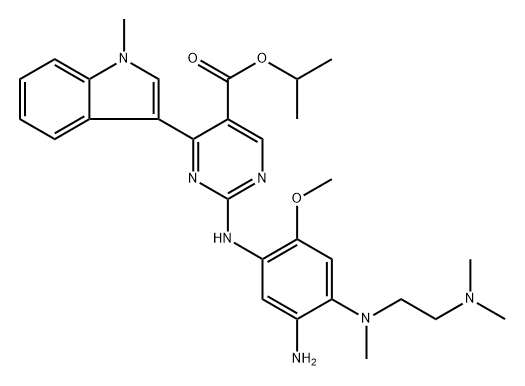Isopropyl 2-((5-amino-4-((2-(dimethylamino)ethyl)(methyl)amino)-2-methoxyphenyl)amino)-4-(1-methyl-1H-indol-3-yl)pyrimidine-5-carboxylate is an intermediate of Mobocertinib (isopropyl 2-((5-acrylamido-4-((2-dimethylamino) ethyl) (methyl) amino)-2-methoxyphenyl). The desired mobocertinib was synthesized by reacting this intermediate (0.14 mmol) in DCM with 1-ethyl-3 (3-dimethylpropylamine) carbodiimide (EDCI; 0.28 mmol), Hunig's base (0.42 mmol), and acrylic acid (0.28 mmol)[1].
The mixture of (methyl 2-((4-((2-(dimethylamino) ethyl) (methyl) amino)-2-methoxy-5-nitrophenyl)amino)-4-(1-methyl-1H-indol-3-yl)pyrimidine-5-carboxylate) (0.21 mmol) in isopropyl alcohol (3 mL) and 0.26 mmol of sodium hydride was refluxed for 5 min and then cooled to obtain a solid red compound, isopropyl 2-((4-((2-(dimethylamino)ethyl)(methyl)amino)-2-methoxy-5-nitrophenyl)amino)-4-(1-methyl-1H-indol-3-yl)pyrimidine-5-carboxylate (Q2). The nitrobenzene group of Q2 was further reduced to aniline derivative by stirring its acetone solution with zinc powder (0.56 mmol) and saturated aqueous ammonium chloride (1.4 mmol) at room temperature for 30 min. The mixture was filtered through a pad of celite and concentrated to obtain isopropyl 2-((5-amino-4-((2-(dimethylamino) ethyl) (methyl) amino)-2-methoxyphenyl) amino)-4-(1-methyl-1H-indol-3-yl) pyrimidine-5-carboxylate (R13) as a solid product[1].
[1] Mohd Imran. “Discovery, Development, Inventions, and Patent Trends on Mobocertinib Succinate: The First-in-Class Oral Treatment for NSCLC with EGFR Exon 20 Insertions.” Biomedicines (2021).
